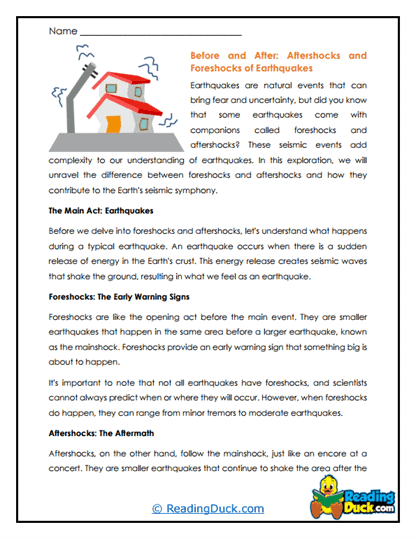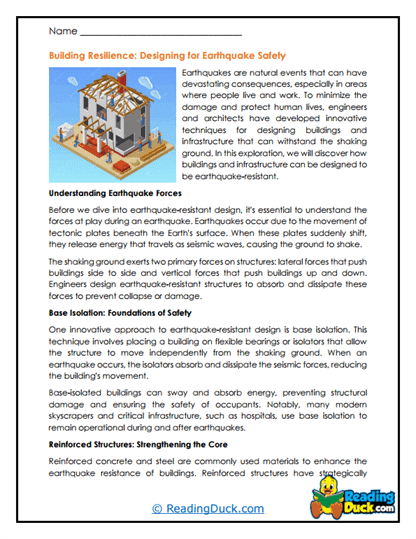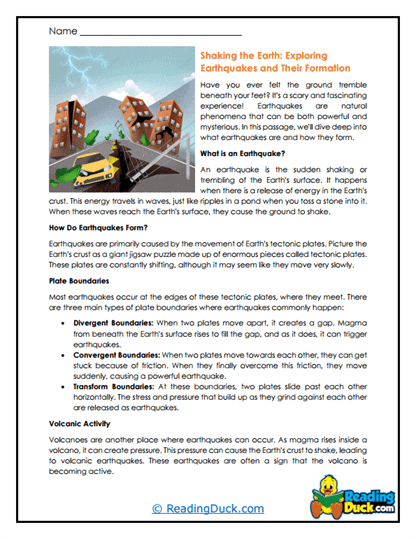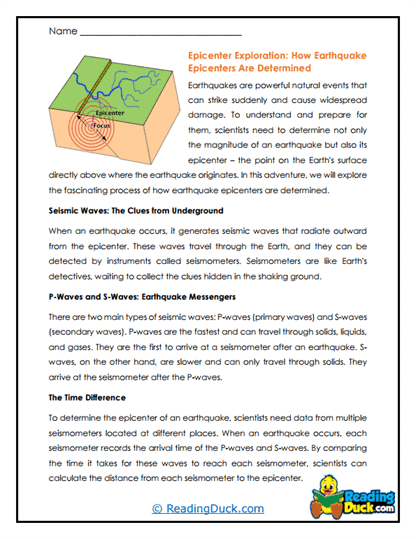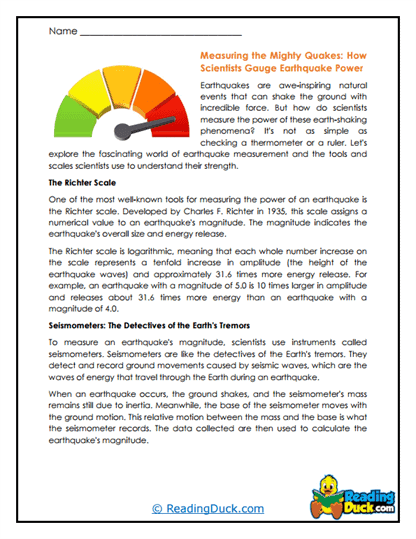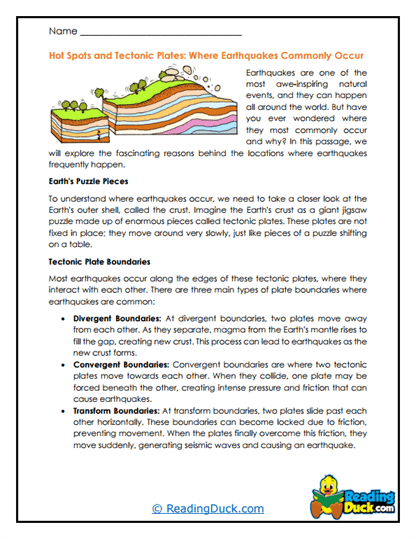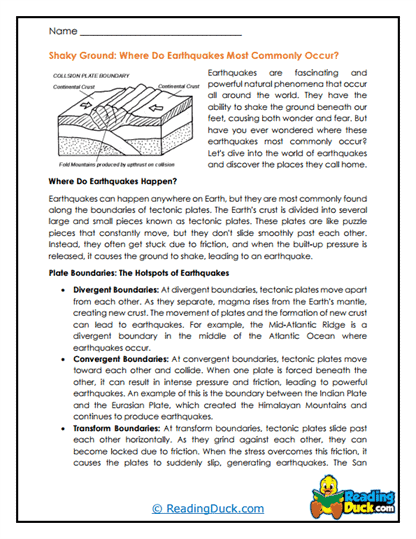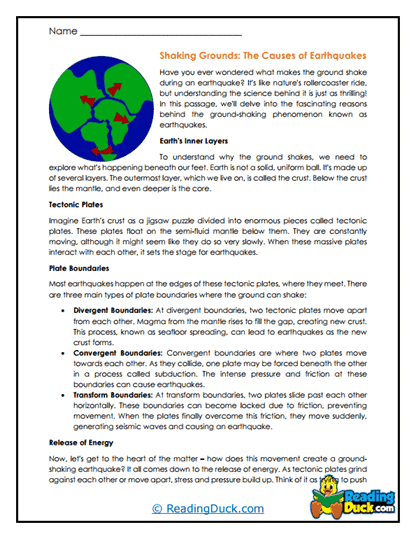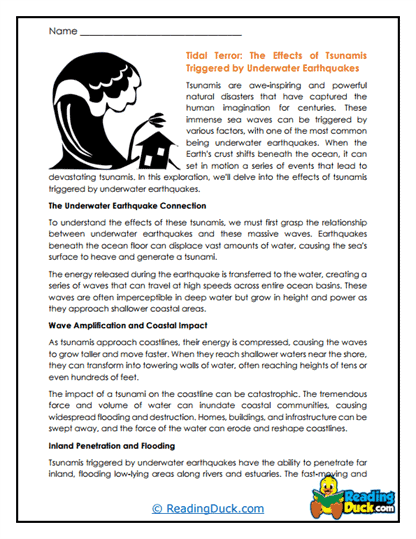Earthquakes Worksheets
About Our Earthquakes Worksheets
Our Earthquakes worksheets provide a comprehensive exploration of one of Earth’s most powerful and fascinating natural phenomena. As a subtopic within Earth Science, this collection is designed to deepen students' understanding of how earthquakes occur, their effects on the planet, and how they are measured. The worksheets in this collection are meticulously crafted to engage students and enhance their learning experience.
Each worksheet set includes a variety of activities designed to cater to different learning styles and assessment needs:
- Multiple Choice Questions: These questions test students’ knowledge of key concepts related to earthquakes, such as tectonic plate movements, fault lines, and the Richter scale.
- Short Answer Questions: These questions encourage students to articulate their understanding of concepts like seismic waves and earthquake preparedness in their own words.
- Open-Ended Questions: These questions invite students to reflect on their personal experiences or opinions about earthquakes, or to explore the implications of earthquake activity on human societies and natural landscapes.
Each worksheet is equipped with an answer key, making it easy for educators to assess students’ comprehension. The worksheets are available in PDF format, ensuring they can be easily accessed, downloaded, and printed for use in classrooms or at home.
Understanding Earthquakes: Forces Beneath the Surface
1. The Science of Earthquakes
- Tectonic Plates and Fault Lines:
- The Earth’s Crust: Earthquakes are primarily caused by the movement of tectonic plates beneath the Earth’s surface. The Earth's crust is divided into several large and small tectonic plates that float on the semi-fluid asthenosphere below. These plates are in constant motion, albeit at very slow rates, which can lead to significant geological activity.
- Fault Lines: Earthquakes often occur along fault lines, which are fractures in the Earth's crust where two blocks of the crust have slipped past each other. The most famous fault line in the United States is the San Andreas Fault in California. Understanding the relationship between tectonic plates and fault lines is crucial for predicting and preparing for earthquakes.
- Seismic Waves:
- Types of Seismic Waves: When an earthquake occurs, it releases energy in the form of seismic waves. There are two main types of seismic waves: body waves and surface waves. Body waves travel through the Earth’s interior, while surface waves travel along the Earth’s surface. Surface waves typically cause the most damage during an earthquake.
- Measuring Seismic Activity: Seismologists use instruments called seismographs to measure the strength and duration of seismic waves. The data collected is then used to determine the earthquake’s magnitude, typically measured on the Richter scale, and its epicenter.
2. The Impact of Earthquakes
- Earthquake Hazards:
- Ground Shaking: The most immediate and noticeable effect of an earthquake is ground shaking. The intensity of the shaking depends on the earthquake’s magnitude, the distance from the epicenter, and the local geological conditions. In areas with loose soil or landfill, the shaking can be amplified, leading to more severe damage.
- Secondary Hazards: Earthquakes can trigger a variety of secondary hazards, including landslides, tsunamis, and liquefaction. Tsunamis are particularly devastating, as they can travel across entire ocean basins and inundate coastal areas with little warning. Liquefaction occurs when saturated soil temporarily loses its strength and behaves like a liquid, which can cause buildings to collapse.
- Human and Environmental Impact:
- Urban Damage: Earthquakes can cause catastrophic damage to buildings, bridges, roads, and other infrastructure. In densely populated urban areas, the potential for loss of life and economic disruption is significant.
- Environmental Effects: Earthquakes can also have profound effects on the natural environment, including changes in the course of rivers, the creation of new landforms, and shifts in the Earth's crust. These changes can alter ecosystems and the availability of natural resources.
3. Earthquake Preparedness and Safety
- Building Resilience:
- Earthquake-Resistant Structures: One of the key strategies for reducing earthquake damage is the construction of earthquake-resistant buildings. These structures are designed to absorb and dissipate seismic energy, minimizing the risk of collapse. Techniques include base isolation, which allows a building to move independently of ground motion, and the use of flexible materials that can withstand shaking.
- Retrofitting Older Buildings: In regions prone to earthquakes, retrofitting older buildings to make them more resistant to seismic activity is crucial. This process involves reinforcing walls, floors, and foundations to improve the building’s ability to withstand shaking.
- Emergency Preparedness:
- Personal Safety Measures: Knowing what to do during an earthquake can save lives. The basic rule is “Drop, Cover, and Hold On” – drop to the ground, take cover under a sturdy piece of furniture, and hold on until the shaking stops. It’s also important to have an emergency kit with essentials like water, food, and first aid supplies.
- Community Preparedness: Communities in earthquake-prone areas often conduct drills and educational programs to prepare residents for the possibility of an earthquake. These programs emphasize the importance of emergency planning, including how to reunite with family members after an earthquake and how to communicate when phone lines are down.
Activities to Supplement These Worksheets
To enhance students’ understanding of earthquakes and make the topic more engaging, consider incorporating these activities into your teaching plan. These hands-on and interactive activities will help students connect theoretical knowledge with real-world applications, deepening their appreciation for the science behind earthquakes.
1. Build a Seismograph Model:
- Objective: Demonstrate how seismographs work and how they measure seismic activity.
- Activity: Guide students in constructing a simple seismograph model using materials like cardboard, a marker, and a roll of paper. Students can simulate an earthquake by shaking the model and observing how the marker records the movement on the paper. This activity helps students visualize how seismic waves are detected and measured.
2. Shake Table Experiment:
- Objective: Explore the effects of earthquakes on buildings and structures.
- Activity: Have students build small structures using materials like toothpicks, marshmallows, or LEGO bricks. Place these structures on a shake table – a device that simulates earthquake vibrations. Students can vary the intensity of the shaking to observe which structures withstand the most force and discuss the design features that contribute to their stability.
3. Earthquake Simulation with Sand and Water:
- Objective: Understand how different soil types and water content affect earthquake damage.
- Activity: Fill trays with different types of soil (dry sand, wet sand, clay) and place small buildings made from blocks on each surface. Shake the trays to simulate an earthquake and observe how the buildings respond. Discuss how liquefaction occurs and why certain soil types are more prone to damage during an earthquake.
4. Map the World’s Earthquakes:
- Objective: Identify patterns in earthquake distribution and understand the relationship between earthquakes and tectonic plate boundaries.
- Activity: Provide students with a world map and a list of recent earthquakes, including their magnitudes and locations. Have students plot the earthquakes on the map and identify patterns, such as clusters along tectonic plate boundaries. This activity reinforces the concept of plate tectonics and helps students visualize where and why earthquakes occur.
5. Research and Present an Earthquake Case Study:
- Objective: Explore the real-world impact of significant earthquakes and the responses to them.
- Activity: Assign students different historical earthquakes (e.g., the 1906 San Francisco earthquake, the 2011 Tōhoku earthquake in Japan) and have them research the event, including its causes, effects, and the recovery efforts. Students can present their findings through reports, presentations, or multimedia projects. This activity allows students to connect scientific concepts with historical and social impacts.
6. Create an Earthquake Preparedness Plan:
- Objective: Develop practical skills for personal and community safety in earthquake-prone areas.
- Activity: Encourage students to create a detailed earthquake preparedness plan for their families. This plan should include steps to take before, during, and after an earthquake, such as securing heavy furniture, identifying safe spots in the home, and assembling an emergency kit. Students can share their plans with the class, discussing the importance of preparedness and the specific risks in their local area.
7. Virtual Field Trip to an Earthquake Research Center:
- Objective: Gain insight into the work of seismologists and the technology used to study earthquakes.
- Activity: Take students on a virtual field trip to an earthquake research center or a seismic monitoring station. Many organizations offer online resources and virtual tours that allow students to see how scientists monitor and analyze seismic activity. This experience can spark interest in careers related to earth sciences and disaster management.
By integrating these activities with our Earthquakes worksheets, teachers and parents can provide students with a well-rounded and engaging learning experience. These activities not only reinforce the concepts covered in the worksheets but also encourage critical thinking, problem-solving, and creativity. They help students understand the science behind earthquakes while emphasizing the importance of safety and preparedness in the face of natural disasters.
